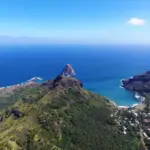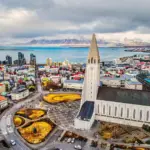
Oman, a hidden gem in the southeastern tip of the Arabian Peninsula, is a country that captivates the imagination with its rich history and stunning landscapes. Located in the Persian Gulf region, Oman is bordered by Saudi Arabia to the west, the United Arab Emirates to the northwest, and Yemen to the southwest.
Where is Oman?
Its strategic geographic location makes this country a meeting point between the Middle East and the Indian subcontinent. This small Arab kingdom covers an area of approximately 309,500 square kilometers, stretching along a coastline that stretches for about 2,000 kilometers along the Arabian Sea and the Indian Ocean.
With impressive geographic diversity, Oman boasts vast coastal plains, imposing mountains, and isolated deserts that are true natural treasures. Oman's privileged geographic location has been instrumental in shaping its rich cultural history.
For centuries, this country was an important trading hub on the ancient sea routes between Asia, Africa, and Europe. This strategic position allowed Oman to thrive as a culturally diverse and cosmopolitan nation.
By understanding Oman's precise location on the world map and recognizing its historical and geographical importance, we can begin to unravel the country's mysteries and charms. From its stunning landscapes to its vibrant culture, Oman is a destination worth exploring. explored and enjoyed by all those seeking an experience authentic in a unique location in the world.
The Majestic Location of Oman on the World Map
Oman, a country of rich history and culture, is located in the southwest region of Asia, on the Arabian Peninsula. Its location on the world map is truly remarkable.. Situated between the geographical coordinates 19° N and 26° N latitude and 55° E and 60° E longitude, Oman extends over a wide and fascinating geographical area.
The country borders three distinct countries: Saudi Arabia to the north, the United Arab Emirates to the northwest, and Yemen to the southwest. This strategic position makes Oman an important intersection point between the Persian Gulf, the Arabian Sea, and the Indian Ocean.

Land Borders: An Enchanting Diversity
Oman's unique geographical position is further emphasized by its land borders with equally notable neighboring countries. Along its western border lies the imposing Saudi Arabia, a country known for its vast desert expanses and important Islamic holy sites.
The northwestern border is shared with the United Arab Emirates, a dynamic federation home to captivating cosmopolitan metropolises like Dubai and Abu Dhabi.. To the southwest lies Yemen, a country full of ancient historic cities and stunning landscapes.
Territorial Extent and Geographical Characteristics of Oman
Oman is a country of impressive size, covering approximately 309,500 square kilometers. Its geography is diverse and fascinating, with a unique combination of imposing mountains, vast plains, spectacular deserts, and an extensive coastline along the Arabian Sea. The country's highest point is Jebel Shams, at approximately 3,028 meters, offering incredible panoramic views for those brave enough to explore its steep slopes.
Oman's privileged geographical location presents its inhabitants and visitors with a variety of spectacular landscapes and unique opportunities. Whether in the majestic mountains or the beautiful beaches along the Indian Ocean, Oman truly captivates all who have the privilege of exploring its lush lands.
Precise location of Oman
Geographic coordinates (latitude and longitude)
Oman is located at the approximate geographic coordinates of 21° N latitude and 57° E longitudeThese coordinates define the country's exact position on the globe, allowing for precise location in relation to other countries and bodies of water. Based on these coordinates, it is possible to understand Oman's strategic position on the Asian continent.
Specific region in the Asian continent
Oman is located in the southwest region of Asia, in an area known as the Arabian Peninsula. The Arabian Peninsula is a territorial extension that extends across southwest Asia, forming a triangle between the Red Sea, the Persian Gulf and the Arabian Sea. Oman's geographic location on the Arabian Peninsula gives it a strategic position between important trade routes and cultural influences that extend throughout the Middle East.
Arabian Peninsula: highlighting Oman's position on the peninsula
Within the Arabian Peninsula, Oman occupies a privileged position in the southeast. Bordered by the United Arab Emirates to the northwest and Saudi Arabia to the west, Oman shares its southern border with Yemen.
This unique location allows Oman to serve as a connecting point between the Persian Gulf and the Indian Ocean, with direct access to important maritime trade routes. Furthermore, its proximity to the Strait of Hormuz, a strategic passage for global oil and maritime trade between the Persian Gulf and the Indian Ocean, gives Oman an even more significant position in the region's geopolitical landscape.
In summary, Oman is located at the approximate geographic coordinates of 21° N latitude and 57° E longitude. Its position on the Asian continent is an integral part of the Arabian Peninsula, which extends across Southwest Asia.
Oman's strategic position on the peninsula contributes to its connection to important maritime trade routes and cultural influences in the Middle East region. As a country connecting the Persian Gulf to the Indian Ocean, Oman plays a crucial role in the global geopolitical landscape.
Land borders of Oman
Neighboring countries to the north, south, east and west
Oman is a charming and unique country located in the eastern region of the Arabian Peninsula. It borders several countries to the north, south, east, and west. These borders not only define its geographic location but also influence its history, culture, and economy.
Saudi Arabia: western border
To the west of Oman lies the imposing Saudi Arabia. With a long border shared between the two countries, this relationship plays a crucial role in the region's trade and diplomatic relations. Furthermore, the geographical proximity allows for a rich exchange of culturally significant between the two nations.
United Arab Emirates: northwest border
To the northwest of Oman lies the beautiful country of the United Arab Emirates (UAE). The border with the UAE is marked by a shared territorial expansion that encompasses vast coastal areas and mountainous territories. This geographic proximity has fostered strong economic and tourism cooperation between the two countries.
Yemen: southwestern border
In southwest Oman lies one of the country's closest neighbors—Yemen. Sharing a long border with Yemen is shocking, especially given the cultural and political differences between the two countries.
This complex relationship has historically been influenced by factors such as cross-border trade, migration, and security concerns. In short, Oman's land borders are crucial to understanding its strategic position in the region.
Neighboring countries—Saudi Arabia, the United Arab Emirates, and Yemen—play a significant role in the country's social, political, and economic interactions. These multifaceted relationships enrich Oman's identity and highlight its importance as a unique nation in the Arabian Peninsula.

Oman's Location in Relation to the Seas and Oceans
Oman, a country with a rich history and culture, is strategically located on the southeastern coast of the Arabian Peninsula. Its privileged geographical position provides direct access to the Arabian Sea, which laps its southeastern shores.
The Arabian Sea is one of the most important seas in the region, connecting Oman to neighboring countries such as India, Pakistan, and Iran. In addition to the Arabian Sea, Oman also has access to the Gulf of Oman to the northeast.
This gulf is an extension of the Indian Ocean and separates the Arabian Peninsula from the Indian subcontinent. Its waters are known for their stunning natural beauty and are home to a variety of marine species.
Oman's coastal position on the Gulf of Oman offers numerous economic opportunities related to fishing, maritime tourism and trade. Finally, we cannot fail to mention the Strait of Hormuz, located north of Oman.
This vital strait connects the Persian Gulf to the Indian Ocean and is a key route for international shipping. Its strategic location makes it a crucial hub for global oil and natural gas trade.
HOW TO GET TO OMAN
There are several ways to get to Oman, the most common being by plane. Below are some options:
- Direct flight: Direct flights are available from some Brazilian cities to Muscat, the capital of Oman. For example, there are direct flights from São Paulo to Muscat.
- Connecting flight: If there are no direct flights available, you can connect in another city. For example, you can fly from Istanbul, Turkey, to Muscat.
To find flights, you can search on websites like Skyscanner, Google Flights, or Expedia. It's important to always remember to buy tickets in advance to avoid problems and get the lowest prices.
which airlines fly to Oman
Some of the airlines that fly to Oman include:
- EmiratesEmirates is one of the main airlines offering flights to Oman. It offers direct flights from São Paulo to Muscat.
- Qatar Airways: Qatar Airways also offers flights to Oman, with connections in Doha, Qatar. You can fly from São Paulo to Muscat with this airline.
- Turkish Airlines: Turkish Airlines is another option for flying to Oman. It offers connecting flights from Istanbul, Turkey, to Muscat.
- Oman Air: Oman Air is the national airline of Oman and offers direct flights from several cities around the world to Muscat. It also operates flights from São Paulo to Muscat.
WHAT TO DO IN OMAN
Oman is a country with many interesting tourist attractions. Below, we list some of the top things to do in Oman:
- Musandam Fjords: Located in the far north of Oman, it is a place of stunning natural beauty.
- Khasab Fort: A 17th-century Portuguese fortress located in the city of Khasab.
- Nizwa Goat Market: A traditional market where you can see goats and other animals for sale, as well as local products.
- Wadi Shab: A canyon with natural pools of crystal clear water, ideal for hiking and swimming.
- Bimmah Sinkhole: A natural saltwater pool surrounded by limestone rocks, located near the city of Muscat.
- Sultan Qaboos Al Alam Royal Palace: A royal palace located in Muscat, the capital of Oman.
- National Museum of Oman: A museum that tells the history and culture of the country.
- Mutrah Souq: A traditional market with a wide variety of products, including spices, jewelry and handicrafts.
- Muscat Corniche: A seaside promenade with panoramic views of the city.
- Muscat Fort on the Corniche: A historic fortress located on the Corniche of Muscat.
- Sultan Qaboos Grand Mosque: An impressive mosque in Muscat with a capacity of 20,000 people.
- Wadi Bani Khalid: A canyon with natural pools of crystal clear water, ideal for hiking and swimming.
- Nizwa Fortress: A historic fortress located in the city of Nizwa.
- Jebel Shams: The highest mountain in Oman, with stunning panoramic views.
- Royal Opera House: A theater in Muscat, known for its impressive architecture.
In addition to these attractions, Oman is also known for its beaches, deserts and stunning natural landscapes.
Conclusion
Oman's location in relation to the seas and oceans plays a fundamental role in the country's economic, social, and cultural development. Its proximity to the Arabian Sea, the Gulf of Oman, and the Strait of Hormuz provides significant commercial opportunities, especially in the maritime sector.
Furthermore, Oman's strategic position allows the country to benefit from the tourism potential of the crystal-clear waters of the Arabian Sea and the stunning landscapes along the coast. These unique natural resources are a source of pride for locals and a draw for international visitors.
In short, Oman's privileged geographical location relative to the seas and oceans plays a crucial role in the country's national identity, its continued economic development, and the promotion of tourism. It is a pearl on the coast of the Arabian Peninsula that deserves to be discovered and appreciated by all those seeking to explore its unique beauty.
Lucas Wanderlust has a tireless spirit of adventure, always seeking new travel experiences. Fascinated by the world and the possibility of exploring unknown destinations, he fell in love with the sense of freedom and self-discovery that traveling alone provides. With a backpack on his back and a heart open to the unknown, Lucas embarks on exciting journeys, where each destination becomes a unique chapter in his life story. He gives himself body and soul to the magic of solo travel, inspiring others to follow in his footsteps and discover themselves through adventure.







